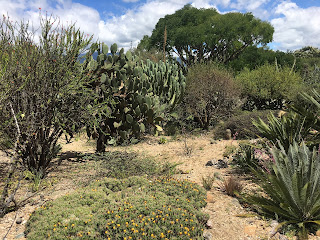Ted. I have
learned a new term. Ethnobotany is the study of plants and their use by humans.
Thus, an ethnobotanical garden emphasizes local plants that were, and often
continue to be useful to the local people. Since residents of the state of Oaxaca have such a rich inventory of plants, our tour of the Oaxaca Ethnobotanical
Garden was fascinating.
I'm not the only one who was impressed. Here is a
link to an article that appeared in the New Your Times a few years ago:
The importance of corn, beans,
and squash over many thousands of years was illustrated very clearly.
I also
learned about the importance of amaranth in the past and present. Google it and
then try it, should you get the chance.
Cotton has been used here since God was
a boy and many local plants were used to dye the cotton and wool. Most
fascinating to me was the cochineal dye. If you check it out on Wikipedia, you
will learn that a little insect in Oaxaca was, after silver, the most important
source of wealth for the Spanish conquistadors.
 |
| The tiny cochineal bug (hard to get in focus) |
I also learned that the
flowers of the frangipani tree have been used locally for thousands of years to
create garlands worn around one’s neck. I saw the same thing in Hawaii where
the trees are known locally as plumeria and the garlands are called leis!
This served as a reminder of something I heard on first arriving in Oaxaca. The local cuisine utilizes over 300 different herbs and spices!





No comments:
Post a Comment